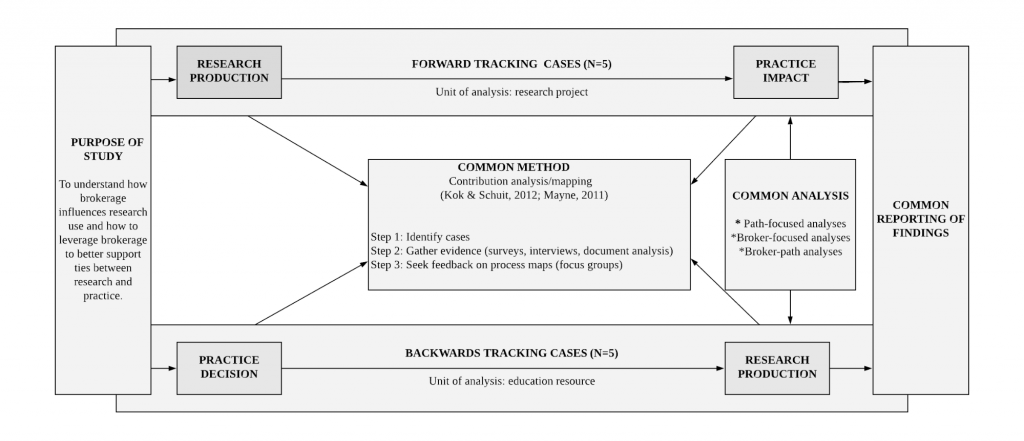Tracking Education Practice to Research
Rationale for Studying Brokerage
To realize the potential for education research to improve teaching and learning we need to better understand the relationship that currently exists between two communities: researchers and school-based educators. For educators and researchers relationships are often indirect, with knowledge and information shared through organizations or individuals referred to as brokers. The potential for brokers to bridge research and practice has been documented in the literature and there is a growing body of studies that focus on describing the roles and activities of these individuals and organizations. While studies of brokers are valuable, we argue that knowledge of what occurs between the production of research findings and their ultimate use (which we define as the ‘third space’) cannot be learned by solely focusing on individual brokers, but rather by focusing on the broader set of actors, relationships, and processes that constitute the system of brokerage.
What We Are Trying To Learn
The purpose of the present study is to map the network of actors, relationships, and processes that constitute the system of research brokerage in education. This project is intended to answer the overarching question: What happens to research and research-based information in the ‘third space?’. In particular, we intend to explore the paths between research and practice through five areas of inquiry.
- AI1. Understanding through which individuals and organizations research passes and the characteristics of those individuals and organizations.
- AI2. Understanding what those identified as engaging in brokerage (in #1) do with education research and why.
- AI3. Understanding how paths through the brokerage network are formed.
- AI4. Understanding how long the path is between research and practice.
- AI5. Understanding the ways in which brokerage is similar and different research use or research production.
The findings of this work will potentially help to understand and explain findings from our descriptive studies of the research and practice communities as well as provide new insights about approaches and levers that can reduce barriers and enhance supports for research-practice relationships.
Our Approach to Studying Brokerage
In an effort to better understand the complex and interactive nature of how research makes its way into school systems, our work is utilizing forward and backward tracking case studies to map the brokerage process. Figure 1 is a visual representation of the key elements of the case studies. As shown in Figure 1, both forward and backward tracking cases use a common: framework, analysis, and reporting.

Framework
For the backward tracking cases, our starting point is on the practitioner side of the divide. We selected a few resources used by educators (as stated in educator responses from the Survey of Evidence in Education) and sought to track them back to their roots in educational research.
For the forward tracking cases, our analysis starts from the research side of the equation. We selected a few education research projects that had direct impacts on practice (as reported by researchers who completed the Survey of Evidence in Education) and sought to trace how they impacted educational practice.
Survey results from the school-based practitioners and researchers who are the ‘starting points’ for this study were pulled for examination. Using the survey data, qualitative summaries for each of the education resources and research projects were developed. Practitioners and researchers were invited to participate in interviews to uncover more information about the selected educational resources and research projects. Where an interviewee mentioned that another actor was involved along the brokerage path (for example, a teacher received an education resource from their superintendent), the research team asked the interviewee to provide the person’s contact information so that we could continue to trace the path of evidence into practice. In addition, relevant documents and other materials were analyzed where available (e.g., research articles, websites, pre-recorded interviews). Interviewees will be asked to provide feedback on our findings and the resulting descriptions of how research was utilized.
Analysis
We will conduct detailed in-depth analyses of single cases and cross-case analyses to reveal patterns concerning which brokerage factors have played a role in research utilization. We anticipate this project involving three major types of analyses:
- Path-focused analysis, including description of paths (e.g. activities, length, outcome) and sequence analysis of paths to generate typology
- Broker-focused analysis, including broker characteristics, motivations, and activities, latent class or latent profile analysis of various types of brokers and brokerage activities
- Broker-path analyses, such as examination of path descriptions and typologies by broker characteristics or types.
What Our Path-Focused Analysis May Look Like Brokerage can, in some cases
Brokerage can, in some cases, be direct and simple: Researcher A provides “useable knowledge” to Broker B, who gives it to User C (e.g. Figure 1).

They are, however, more likely to be complex, and involve multiple brokers performing multiple tasks that support use.

Why We Are Sharing Our Work
As results from this study become available, we will disseminate information through conferences, research articles, and through targeted and accessible resources for educators, brokers, and researchers.
Check out our new Resources Library!
We are currently busy writing! Follow us on Twitter to know when we release something!



